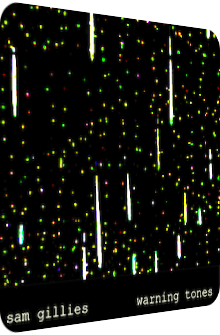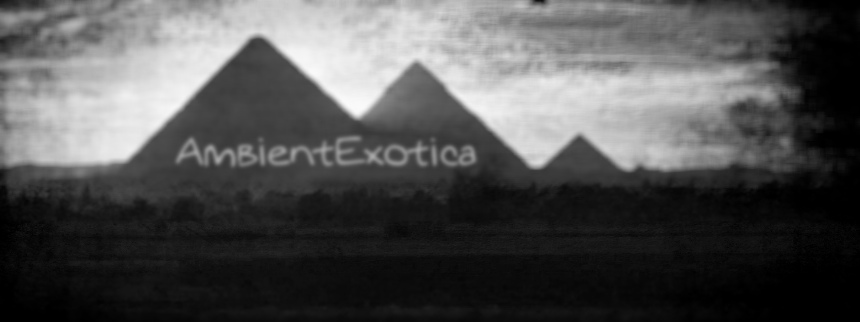
Sam Gillies
Warning Tones
2013
Warning Tones is a downright apocalyptical twelve-vignette concept album of the noisy Drone kind by the West Australia-based composer and film maker Sam Gillies, self-released in March 2013 and available to purchase and listen to in full at Bandcamp. All twelve tracks cross-fade into the respective follow-up and cannot be told apart if one does not take a glimpse at the titles or runtimes, even though all of them have their distinctive features, periods of placidity and convulsions of overwhelming noise levels. Gillies is keen on programming interactive environments, and while music albums in the classical sense cannot be truly interactive, for each specific tone happens to appear at the exact same time as it previously did and always will, the artist’s vision comes very close in this regard by – and here comes the first of many oxymorons – implicitly confronting the listener with an enormously important prerogative of interpretation he or she has to apply: since Warning Tones is an album about a vaguely circumscribed incident or impact of the horrifying and devastating kind, does this very event happen before the start of the album, i.e. beyond its physical boundaries and periphery, and if so, does this incident reoccur in a cryptical way?
These musings are all the more pressing and nerve-racking when Sam Gillies’ envisioned sound layers become increasingly baleful and calamitous. Dungeon-like drone sounds, spacey blisters, destroyed frequencies, but also moments of relative peace and shelter meet, merge and depart incessantly. Added to their contingent characteristics are samples of supposed victims who were surprised by “it” aka that incident. This concept harks back to an idea which Gillies already had in 2008. Says the artist in the liner notes: “In Warning Tones the conversations and interviews relate to natural disasters and events that have happened in a number of different places and attempts to re-frame them as a commentary on a single event, stripping away the event itself and focusing on the human reaction to any given disaster.” So far, so worrisome. But since these different events now form the amalgamation of a new one, the will to interpret this newly formed singular incident grows ever-stronger, while Sam Gillies’ answers become increasingly indecipherable at the same time. The front artwork may give a hint at several cometary impacts or acidic rain drops, but again, this could be a diversionary maneuver. The resulting widening gap meanwhile is the aesthetic cusp which is filled with life and doom by the composer. I dare a trip into this destructed realm.
Oh the duality! Does an opener called Impact already unleash the climactic revelation right at the beginning, despite serving the purpose of a prelude? It does indeed, and it can only go downhill from here, but this is Sam Gillies’ intention and purely related to the aesthetics of his vision and not based on the qualitative aspects of the vignettes themselves. Impact is not even a poignant title for this piece, as there are no expected peals of thunder, nor are there staggering bass blasts. The opener on the contrary underwhelms, and decidedly so: pawing static noise signals, disturbingly processed electric guitar coils and terraqueous bubbles beguile the desolated listening subject. A few stereo panning effects round the base frame off. This is no song in the commonly accepted terms, but really just the anacrusis to the aftermath, if that makes any sense. Overtones explicates the tractive force of the West Australian-based composer much more clearly and forcefully. A muffled female voice echoes through the brazen creakscape of dazzling vinyl crackles, eminently silkened disk saw rotations and the occasional noise burst. What follows is a stokehold drama in the shape of heavy heater blowers, related recirculation pumps and abyssal darkness. The atmosphere of a plant site’s cellar is created, and only the most dedicated listeners of the Drone genre will not be bewildered in terms of the warmth that is found in this piece. Sam Gillies distributes cavalcades of pink noise, the sounds are comparably softened and thermal, by no means harsh or glitchy.
As if the artist sensed the caused frowns, It Seems So Surreal addresses this very wonderment via its title which is also uttered in a similar way by a metallically muffled male voice. During all the time the key sentence is looped, gunmetal-colored glacial streams alloy the jejune atmosphere which is then revved up by Sliding Planes and its malfunctioning transistor radio heterodynes. Below these frequencies, spheroidally bouncing vesicles are bubbling. Their tendrils increase in voluminosity, but so do the volumetric protrusions, creating a stop-and-go staccato of alkaline paroxysms. The much longer and especially malevolent Phases ventures deeper into the matter and invites the listener to a mad scientist’s lair, or so it seems; bleeping pulses, omnipresent warning tones, bellicose flumes, extirpated interstices and screeching prongs create a bustling frenzy whose baneful maelstrom becomes all the more hazardous the louder the listener turns up the headphones or speakers. Phases shows its real apparition – another oxymoron in itself – in the middle section, where it is traversed by sudden flashbacks of the mysterious impact. Hyperviolent outbursts, explosions and fulminations crash through the sound layers all of a sudden before everything returns back to, er, abnormal. The impetus and oomph of these explosions is medulla-emptying, bone-crushing and soul-destroying, so be cautious… this is the series of impacts the opener promised and did not deliver!
The eponymous Warning Tones is the much-needed contravention to the increasingly forceful urgency. This drip stone cavern may contain shadows of these expectorating bursts, but otherwise paints a somnolent aura via the moist droplets, heavily reverberated clangs and rather soothing chinks. It Made Me Think The Worst is then based on a man’s utterance regarding his sister who was sitting next to him when thick smoke took over their house and caused temporary blindness and irritations. Instead of gaseous cloudlets which would fit the scenery, Sam Gillies only injects their ashen afterglow and otherwise relies heavily on a reverb-coated tinkling, rattling and multitudinous rotor-esque guitar layers which are illuminated by an effulgent signal chime. This polar light becomes more danger-evoking later on when it returns to tones in minor and pierces through the putrefaction. Afterwards, People Are Wearing Masks functions as a short interlude of a worried women lamenting about scar(r)ed people and their mask-wearing helpers… and one can only hope that these are charitable cherubims rather than ferocious foes.
Misinformation serves as the centerpiece of the album length-wise with a runtime of over eight minutes (although there is one additional longer piece left which, however, cannot possibly be called a centerpiece). Its title is more meaningful than ever in our globalized and super-connected world where there is literally no escape from the very thing one tries to, well, either cover or escape from, whatever this may be. Here, in Sam Gillies’ dystopian wastelands, the title implies the governmental dilution processes by covering the real reason for the sudden incident that potentially happens before the actual start of the album. One almost begs for a sign of life, a comment by a witness or victim, but no can do. This is an instrumental, but a wondrously quirky and alienating one. Electric currents flow over the formerly erbaceous soils, spluttering and hissing energetically while superb Space-Age beeps and bit-crushed polyphonies fathom out quasi-transcendental states of dissonance and euphony. This is one of the most imaginative pieces whose dichotomy does not clash rather than becoming delicately enmeshed. Danger In The Air, however, revisits the harsher climes in full force, although its cosmic jitters and frolicking frequencies feel like liquedous rain showers next to the noisy fluxion of jagged fractions and pernicious ruptures. The alarming tohubohu that is Evacuation then pulls the listening subject away from the turmoil rather than throwing him or her into the bedlam. From a distance, a droning stream of fuzziness in tandem with a flurry of activity is watched, presumably from a safe outlook. Far away sirens, public service announcements, klaxon horns and the rattling of military equipment become intertwined. The soothing riverbed of this tune is all the more disturbing if one considers the surrounding tension and increasing impetus of these incidents. The non-revelatory finale is called Any Given Moment and lets the album come full circle while leaving the pressing question whether the impact of the opener will reoccur yet again, and several times so, or whether the title of this closer refers to the end cycle of this devastating condition. Bonfire-like crackles, ophidian hisses, machineries and abhorrently thuggish-tramontane acid lines mark the definite end whose finish slowly fades into the pith of nullity.
Warning Tones is an intensely frightening album, and the reasons for this trifold step from a mere premonition over a clearer presumption to a demonic pandemonium lead to the terrific chicanery of Sam Gillies who astutely plays with the fear of the listener rather than moulding the scary thoughts into a manifestation of sounds. There is only one definitely shocking appearance of grinding-gargantuan proportions, and these are found in the vignette called Phases where the formerly looming impacts become a staggering, highly explosive reality in flashback form. Otherwise, the album remains vague. What all the ado is about remains a mystery. Heck, Gillies does not even reveal whether the apocalyptic incident happens right now, has already happened or will happen immediately. There are justifiable reasons which verify all of these timelines. I am of the opinion that the cinematic storyline of the album sets in right after the impact, with the evacuation being one of the final instances. Things could be different, though. Very different even. The evacuation could, as I previously implied, be caused by another catastrophe, one that must not necessarily be causally linked to the previous one(s).
Be that as it may, rarely did I contemplate as much about a concept album of 2013 as in regard to Warning Tones. There are two particular things which Sam Gillies does terrifically right: firstly, he lets the album start after the incident – I presume! – and remains very vague about its nature. Whether it is a natural disaster, a military coup de main or a galactic encounter is not resolved. And secondly, he uses the nostalgia layering technique by sampling unrelated reports, opinions and explanations by various people who have not even witnessed the same devastating incidents in real life, but suddenly and exclusively seem connected to each other in the apocryphal antra of Warning Tones. It is the brains that play tricks on us all. Warning Tones is a creepy brute of an album, droning alatorically, with infinitesimal melodies few and far between the interstitial fissures, traversed by flashing streams, metallic surfaces and mind-bending tons of steel. But I would not even be surprised if the latter were in fact steel-bending tons of minds.
Further listening and reading:
- You can purchase and listen to Warning Tones in full at Bandcamp.
- Discover more about the album and the artist at SamGillies.com.
Ambient Review 248: Sam Gillies – Warning Tones (2013). Originally published on Aug. 7, 2013 at AmbientExotica.com.
